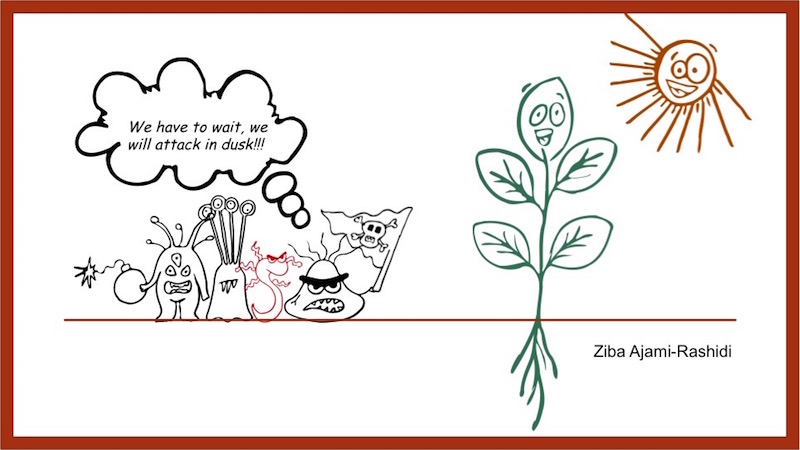Under cover of darkness
Pathogen attack in darkness does not induce plant long term defense regulators as vigorously as in light.
Unlike animals, plants are sessile and sensitive to slight changes in their surrounding environment. To cope with a variety of biotic and abiotic stresses, plants are able to employ diverse resistance mechanisms. One of these sophisticated mechanisms is termed systemic acquired resistance (SAR) which is a long-lasting induced resistance to secondary pathogen infection in the whole plant after recognition of a first pathogen attack. In the Arabidopsis thaliana / Pseudomonas syringae pathosystem, pathogen induction of local responses is associated with the activation of mobile signals which might be translocated to leaves distal to the infection site. Our group demonstrated that pipecolic acid (Pip), a non-protein amino acid biosynthesized from lysine, plays a key role in SAR activation and the establishment of a primed state associated with SAR. Beside Pip, there are several other proposed SAR signals such as methylsalicylate (MeSA), diterpenoid dehydroabietinal(DA), glycerol-3-phosphate (G3P), and azelaic acid (AzA). Previous studies on long distance signalling indicate that the time of day of the primary infection, and therefore the length of the light period prior to infection, might be a factor that determines the significance of signal-contribution to SAR establishment. Beside light, other environmental factors such as nitrogen supply can be a determinant that affects the biosynthesis and function of putative SAR signals. Based on our experimental results, we proved that the biosynthesis of Pip and the functional role of Pip as a regulator of defense priming are light-dependent processes.
Our project within CEPLAS, aims to define how and to which extent the biosynthesis and function of main SAR regulators (especially pipecolic acid) are light dependent. Moreover, we want to unravel the interplay among putative SAR signals and contributing elements in the context of morning and evening pathogen inoculation. Our future goal is to better understand how plants integrate different signalling pathways to optimise their responses to simultaneous abiotic and biotic stressors.
Contribution by Ziba Ajami-Rashidi, Institute of Molecular Ecophysiology of Plants, Heinrich Heine University, Düsseldorf
Planter’s Punch
Under the heading Planter’s Punch we present each month one special aspect of the CEPLAS research programme. All contributions are prepared by our young researchers.
Corresponding publications
Griebel T, Zeier J (2008) Light Regulation and Daytime Dependency of Inducible Plant Defenses in Arabidopsis: Phytochrome Signaling Controls Systemic Acquired Resistance Rather Than Local Defense. Plant physiology 147(2):790-801. [Abstract]
Návarová H, Bernsdorff F, Döring AC, Zeier J (2012) Pipecolic Acid, an Endogenous Mediator of Defense Amplification and Priming, Is a Critical Regulator of Inducible Plant Immunity. The Plant cell 24(12):5123-5141. [Abstract]
Bernsdorff F, Döring AC, Gruner K, Schuck S, Bräutigam A, Zeier J (2016) Pipecolic Acid Orchestrates Plant Systemic Acquired Resistance and Defense Priming via Salicylic Acid-Dependent and -Independent Pathways. The Plant cell 28(1):102-129. [Abstract]
